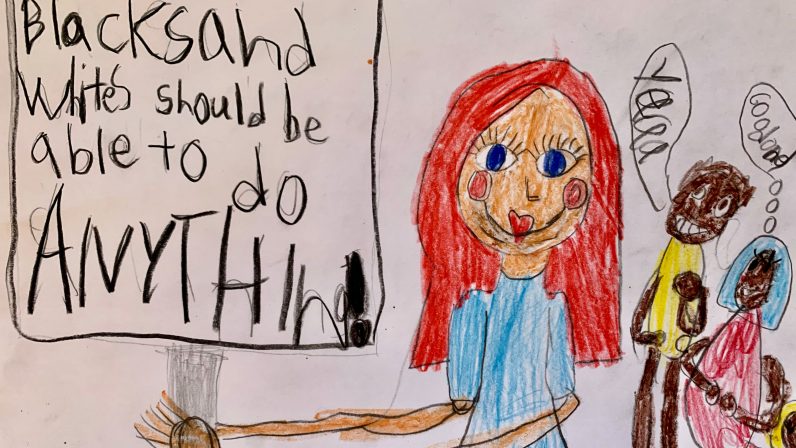Our planned conversation about Dr. Seuss books was postponed until after spring break. It’s a topic our entire lead staff is interested in, particularly as we develop curriculum that supports social justice. We needed more time, and I have confidence that it will be a robust conversation when it happens.
In the mean time, other significant conversations continue to take place. In my ongoing writing work with the two oldest classes, we have been learning some of the vocabulary of social justice, including ally, empathy, protest, stereotype, identity, and freedom fighters. This week the 1st/2nd graders were discussing a book they’d recently read called Child of the Civil Rights Movement. One of the main themes is marching for civil rights. This led to a discussion about what each child would march for, given the opportunity. Together we made a list that included ending segregation, equal rights, women’s rights, and climate change.
Once the list was completed, children were asked to draw a protest sign, write their message on the sign, then draw themselves and others in the picture. After several clarification questions, one thoughtful girl asked, “Can I draw myself White if I’m marching?” Her question took my breath away. The book was narrated from the perspective of a young Black girl. As I looked back through the illustrations, I noticed people in the marches were primarily portrayed with dark skin. I explained that throughout history, people of all colors have marched and supported civil rights. I added that last summer during the Black Lives Matter protests, there were all colors of people who participated. In fact, it was a noteworthy element of the summer movement.
As the children got busy with their drawings about a cause they’d be willing to march for, I thought again about the student’s question: Can I draw myself White if I’m marching? Both personally and as an educator, her question made me reflect on my own Whiteness. The past several months have deepened my relationship with myself as it relates to social justice. Now more than ever, I know that my White face needs to be an active presence in the ongoing work of the movement. My White voice must grow into a stronger instrument of change. My White mind must stay curious and learn from the wise ones who are currently showing us the way. Meanwhile, my White heart will remain open, as I daily translate all I’m learning and thinking into lessons that can be offered to the young activists with whom I spend my days.
(art work courtesy of Cora Bergin)

